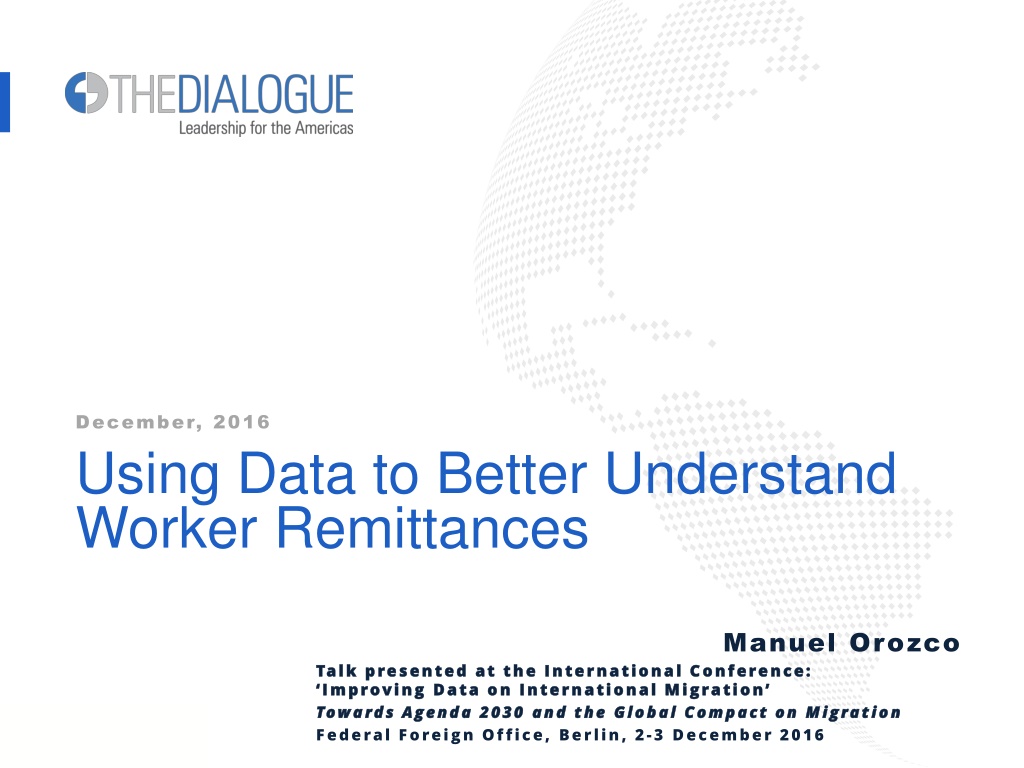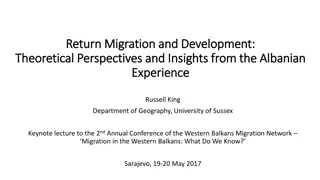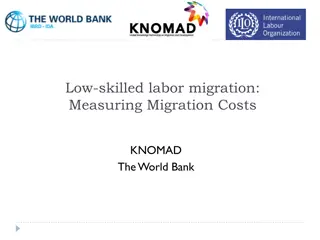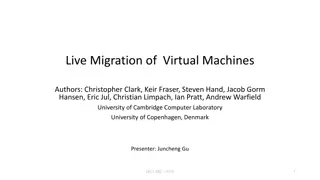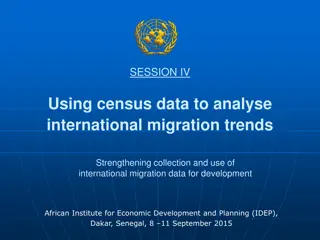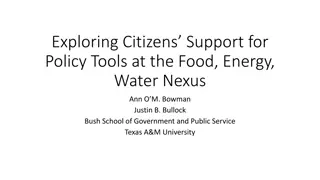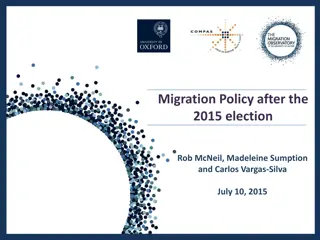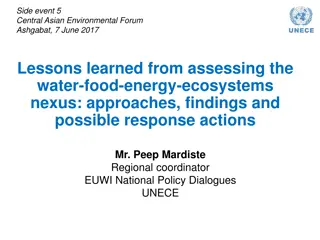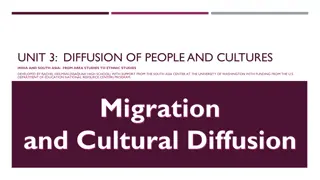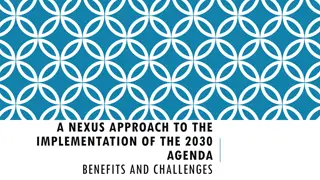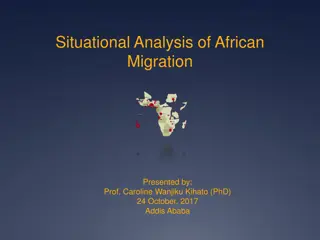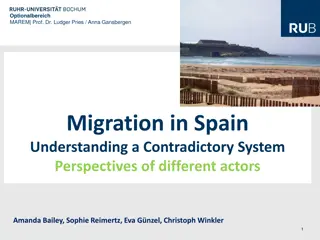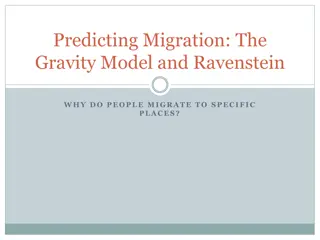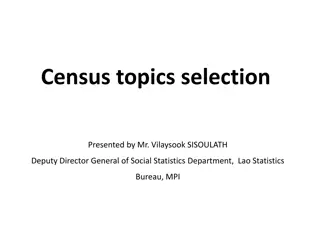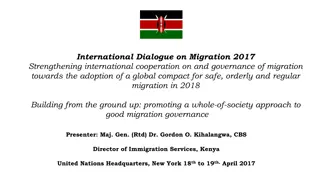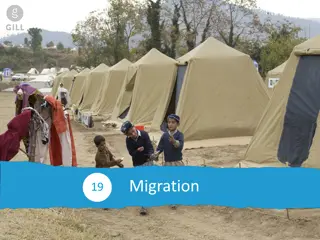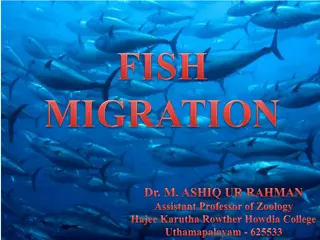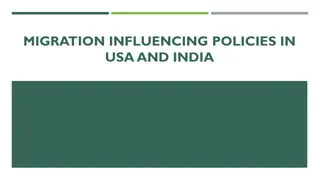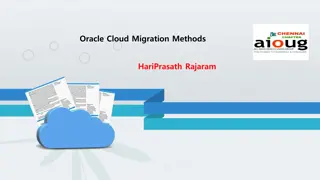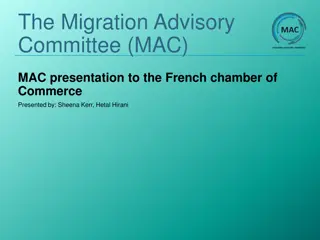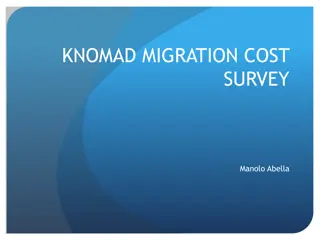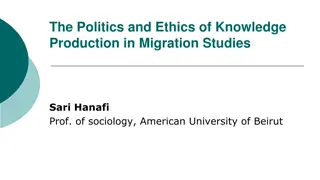Understanding Migration and Development Nexus through Data Analysis
Exploring the intersection of migration and development through data analysis, this content discusses the importance of research frameworks, policy considerations, and units of analysis in understanding worker remittances. It highlights the various activities migrants engage in, such as remitting, investing, consuming, and philanthropy, shedding light on the complex dynamics of migration's impact on both home and host countries.
Download Presentation

Please find below an Image/Link to download the presentation.
The content on the website is provided AS IS for your information and personal use only. It may not be sold, licensed, or shared on other websites without obtaining consent from the author. Download presentation by click this link. If you encounter any issues during the download, it is possible that the publisher has removed the file from their server.
E N D
Presentation Transcript
December, 2016 Using Data to Better Understand Worker Remittances Manuel Orozco Talk presented at the International Conference: Talk presented at the International Conference: Improving Improving Data on International Migration Data on International Migration Towards Agenda 2030 and the Global Compact on Migration Towards Agenda 2030 and the Global Compact on Migration Federal Foreign Office, Berlin, 2-3 December 2016
How to improve data on remittances and remittance transaction costs? When it comes to looking at data within the context of migration and development, is important to take into consideration a few points: First, what is the research framework informing the scope and depth of the relationship migration- development? What is the link between remittances and development? What policy considerations should be addressed within that link?
Units of analysis that guide data collection Data, or the systematization of facts through methods that make knowledge measurable depends on a conceptual framework, measuring methods, analytical tools and policy guidance; Conceptualization is not arbitrary but respond to five units of analysis, namely: Actors (primary, intervening, secondary), Dynamics (mobility, engagement, return), Economic [social, political] activities (remitting, investing, consuming, giving, sharing); Norms and rules and spaces of operation
Some Units of Analysis intersecting Migration and Development during the life as migrants engaging their homeland Host Country Home country Adult Migrants Participating Intermediatio n The scope of engagement: complex and goes beyond costs: Activity associated with Remittance service providers 60%-80% The decision to remit a share of the workers income Consumption of home- country goods or services Raise funds to donate to the hometown Effect of remittances on family household economics Family remittances 80%-90% Supply chain of products and services Transfer and donation implementation mechanisms The enabling environment to form a business Production chain of home country goods Consumpti on 10%-20% Funds received and projects implemented Philanthrop y 5%-10% The decision to create or maintain a minority owned business Creating a micro or small enterprise by an immigrant or family member in homeland Allocating capital for a particular asset or venture in the hometown Entreprene urship 5%-10% The effort to allocate capital for a particular investment or business venture Information and skills acquired as development tools The investment environment Investment 5% Institutions forming skills in the knowledge economy Methods to share information, knowledge and skills that enhance local and national development Knowledge transfer
More specifically on remittances Activities or Issues Associated to Remittances Market intermediation for remittances 1. Regulatory environment: access-barriers to entry, foreign currency deposits; AML, 2. anti-terrorism, and other rules 3. Type of intermediaries: licensed-unlicensed 4. Competition on the payout Financial inclusion issues 1. Remittance recipients and effects of remittances on income 2. Expenditure and local market demand 3. Expenditure and taxation 4. Savings capability, money management and financial access 5. Banking services to remittance recipients: scope (loans, payments, savings) 6. Banking services to remittance recipients: depth (geographic dispersion) 7. Microfinance credit and financial inclusion to recipients
Marketplace Intermediation: -Players -Dynamics -Activities; -Norms, rules; -Spaces of operation
Unit of Analysis: Marketplace Intermediation Remittance transfers are shaped by rules and the existing marketplace that intermediates the transfers. These rules, as well as supply and demand in this remittance marketplace, significantly shape the transfer process. Migrants buy foreign currency to send to relatives at a certain price; in this context, money is treated as a commodity, or a good for which people have a demand. The purchase of such currency is regulated through legislation pertaining to foreign currency controls of different kinds (authorized entities, financial crimes, consumer protection, sovereignty). These rules are one component of the transfer process, as intermediaries must deal with different issues relating to development. Other aspects of the money transfer include The legal position of the transfer (licensed or unlicensed) The sending methods (cash or account) The mechanisms utilized (front-end technology or ancillary tools) The extent of competition in the origin by remittance service providers The destination by payers (Banks, Forex, Microfinance institutions, etc). In addition, there are value added elements in the transfer, such as opportunities for migrants to achieve financial access.
An Issue for Debate: the Costs of Sending Remittance services are often considered to be expensive and inefficient. However it is important to consider three questions: What drives the assumption that costs are high? Can costs reasonably be lowered? What impact would this have on development? Finally, are we asking the right question, given the relationship between migration and development and the role of intermediation? The literature on transaction costs does not say why prices are high or low , they simply say they are expensive. The statement appears more as a normative rather than empirically founded explanation. Why is 6% to send $200 considered expensive? Or why is it expensive to pay $9 to send $300? Is it an arbitrary pricing scheme or is it based competition and operating costs?
An Issue for Debate: the Costs of Sending It is important to unpack the attributes and properties shaping a transaction cost as they relate to the intermediation process. Thus, we find that cost operates in an interplay of supply and demand factors. Region Regulations Average Total cost* 9% 9% 9% 8% 8% 7% 7% 7% 7% 6% 5% 2% Rural Population Competitio n Economies of scale Operating costs Southern Africa Pacific Northern Africa Eastern Europe South East Asia Middle East Caucasus-Balkan South Asia Caribbean South America Central America and Mexico Central Asia 61% 68% 40% 39% 53% 32% 37% 67% 41% 33% 40% 59% Restrictive Moderate Moderate Restrictive Moderate Moderate Restrictive Restrictive Open Open Open Open Weak Weak Moderate Weak Strong Moderate Strong Strong Moderate Strong Strong Strong Limited Limited Moderate Moderate Large Large Moderate Large Large Large Large Large Expensive Expensive Expensive Moderate Low Moderate Moderate Moderate Moderate Low Low Low
Analyzing Data on Costs depends on Assessing the Units of Analysis: attributes and properties of sending money. Determinants of costs Variable Fee Exchange rate spread Total cost Fee as percent of total cost Total percent cost Exchange rate spread as percent of total cost Number of Agents in the US Payout Branches (number of agent locations in the destination) Payout locations as share of all RSP locations RSP Market share, 2014 Country Market size (Volume USD Million) Source World Bank Remittance Pricing Database, 3rd Quarter 2015 IAD data collection World Bank Data IAD data collection Number of Annual Remittance Transactions
Analyzing Data: Latin America and Southern Europe Specifically, increases in price is statistically significant and positively correlated with increases in more agents in the origin and payout, with higher risk posed to a country and with the spread of the exchange rate. The model shows that prices increase 7 basis points when a country risk is higher and 9 basis points when the exchange rate spread increases. Agents in the origin and destination also affect pricing, but particularly in the payout. Southern Europe is one of the most expensive regions to send money from, with transfer costs typically around 7% There is a statistical correlation between costs and economies of scale, type of RSP, number of payout locations in the destination, presence outside the capital and number of RSPs in the origination.
Competition & Financial Access An alternative way to look at remittance marketplace intermediation: competition and financial access Variable Metric Scope of services and operation Competitors Number of RSPs in a country corridor Number of products offered by the RSP Products Countries in which it operates Fee charged FX charged Total cost Payment points Number of all countries served Consumer transaction costs Network of operation Average fee for all countries Average Fx for all countries Average fee plus Average Fx Sum of an RSP s total payment points Sum of an RSP s total payment points divided by the number of countries in which the RSP operates Average percentages for each country Percent of all payment points that are rural Banks payment points / All payment points MFI payment points / all payment points Extent to which call centers or tellers are helpful to clients Payment points / Country Payment points / Network Financial access Rural/Urban Ratio Bank partners as ratio of all payment points MFI partners as ratio of all payment points Client support
Some conclusions We are not asking the right questions what is the relationship between migration and development, and how should it be addressed? What role do remittances play in development? A matter of bias: remittances have been assumed to be the only practical measurable unit related to development; The choice of using cost for analysis reflects a crude rational choice approach Consequences: incomplete and inaccurate policy guidance Issues are excluded, such as asset building and financial inclusion Cost assumptions were not validated but posed normatively not empirically
The Policy Problem Choice of data depends on framing the issues. Issue framing is shaped by uniformed decisions, untested assumptions and limited consultation and cooperation; The problem is not lack of data; we live in a noisy knowledge space, rather there is prevalence of messaging over content and rigor;
Transfers Costs from Southern Europe If the Cost will Size of the market is larger Originator is an MTO Number of partner locations is widespread Larger share of payout locations are in the capital Number of RSPs is large Source: Manuel Orozco, The Remittance Marketplace in Europe, 2015. See http://www.thedialogue.org/resources/the- remittance-marketplace-in-europe-competition-and-pricing/
Transaction Costs: Supply Side Issues Remittance pricing is the byproduct of the operating costs to run a particular business. These operating costs are based on fixed and variable costs; for example, quantities, production costs to run known quantities (commissions to agents), and other cost center related expenses (administration, compliance, information and communication technology support, marketing, and call center client support, for example). The current and prevailing business model is predominantly demand-driven: immigrants continue to prefer cash transfers, at least on the payout. To break it down, this model includes costs related to origination and destination agents (typically 40% of the revenue), and operating costs related to the management of the business. However, as data on costs has shown, average pricing is quite variable across countries and service providers. Why, if remittance transfer services are sold or serviced as a commodity (a product delivered), do their prices vary across corridors and companies? What determines price differences between Haiti and Honduras, for example?
Analyzing data: Latin America & Southern Europe One way to analyze costs is by considering whether price differences are influenced by some of the components that make up for the expenses (such as fee and exchange rate commissions to agents, compliance, or economies of scale). To assess pricing determinants, one can look at factors directly connected to the business operation: agents in the origin and destination, changes in the exchange rate (fees are typically fixed, so don t change), compliance costs resulting from higher risk locations, market share, and economies of scale. The following model is thus used to test some of the determinants of cost. Log (Pricing) = Agents + Payers + FX + Country Risk + RSP market share + Country volume
Analyzing data: Latin America & Southern Europe The following assumptions are highlighted from the model: An RSP that has a far greater number of originating and/or paying agents will have a higher price because it has to recover its commission costs distributed to a larger group; otherwise it faces the law of diminishing returns (it can add more agents, but its product will be the same, yet, it will cost more, and therefore it has to adjust its price). An RSP that has a higher market share in a corridor will be able to afford or risk offering a higher price because it can bet on losing a fraction of clients if the price is too expensive; An RSP that works in a country with higher financial risks will have to spend more on regulatory compliance (AML practices, for example), and thus will increase pricing. An RSP that works in a country with small economies of scale in its volume or number of transfers will face diminishing returns.
Analyzing Data: Latin America and Southern Europe The results of a regression OLS model confirm the hypotheses of cost determinants. Specifically, increases in price is statistically significant and positively correlated with increases in more agents in the origin and payout, with higher risk posed to a country and with the spread of the exchange rate. The model shows that prices increase 7 basis points when a country risk is higher and 9 basis points when the exchange rate spread increases. Agents in the origin and destination also affect pricing, but particularly in the payout.
Transfers Costs from Southern Europe Southern Europe is one of the most expensive regions to send money from, with transfer costs typically around 7% There is a statistical correlation between costs and economies of scale, type of RSP, number of payout locations in the destination, presence outside the capital and number of RSPs in the origination. In addition to the number of competitors, particularly MTOs, the presence of payout locations contributes to lower costs. Consumers like to ensure that their transfers arrive as close as possible to their family s residence. The more payers and closer their locations to the beneficiary, the lower the cost because all companies seek to capture as many locations as possible. In South Eastern Europe there are over three hundred thousand payout locations, two thirds of which are in Ukraine. Not only are there numerous payment points, but the types of payment points are more diverse than other regions.
Transfers Costs from Southern Europe If the Cost will Size of the market is larger Originator is an MTO Number of partner locations is widespread Larger share of payout locations are in the capital Number of RSPs is large Source: Manuel Orozco, The Remittance Marketplace in Europe, 2015. See http://www.thedialogue.org/resources/the- remittance-marketplace-in-europe-competition-and-pricing/
Understanding Transaction Costs: Consumer Side Issues Although the destination country is a significant factor in the cost, there are some consumer-side characteristics that help differentiate between those that pay more and those that pay less. Those who send to their closest relatives pay less. Part of the reason is that the more one remits, the less one is paying relative to the principal amount. Therefore, those sending over US$300 will pay $9 compared to those sending $250, for example (closet relatives receive more). Those who have full time employment also pay less, relative to what they send. Moreover, the choice of company determines cost. Those who think their RSP is inexpensive and transparent in its pricing pay up to 10% less, but those who say their RSP is easy to use pay up to 7% more for the service. Those who send more often and for longer will be paying 5-10% more. However, if they are sending more they will pay less as a percentage.
Beyond Remittances: The Units of Analysis in Migration and Development One of the problems with the analysis of transaction costs is the assumption that it is a key development policy issue. Instead, we need to start by validating the intersecting issues between migration and development. The engagement or links that migrants establish through transnational economic activities, such as family remittances, are accompanied by several processes that together constitute or a development chain. These activities include Money transfers (family remittances), Entrepreneurship, Capital investment Philanthropy, Consumption of home-country products (the nostalgia trade), and Knowledge transfer. These activities occur at various stages in the migration process, and relate to the host country, to intermediation, and to the home country. They represent central units of analysis. These activities and moments are what form the value chain. At least two critical development factors, financial and market access are present in this relationship, and the efficient performance of these two ensures the success of the value chain.
Beyond Remittances: The Units of Analysis in Migration and Development The scope of engagement is more complex and goes beyond costs: Host Country Intermediation Home country Adult Migrants Participating Activity associated with 60%-80% The decision to remit a share of the workers income Remittance service providers Effect of remittances on family household economics Family remittances 80%-90% Consumption of home- country goods or services Supply chain of products and services Transfer and donation implementation mechanisms The enabling environment to form a business The investment environment Production chain of home country goods Consumption 10%-20% Raise funds to donate to the hometown Funds received and projects implemented Philanthropy 5%-10% The decision to create or maintain a minority owned business The effort to allocate capital for a particular investment or business venture Information and skills acquired as development tools Creating a micro or small enterprise by an immigrant or family member in homeland Allocating capital for a particular asset or venture in the hometown Entrepreneurship 5%-10% Investment 5% Institutions forming skills in the knowledge economy Methods to share information, knowledge and skills that enhance local and national development Knowledge transfer
Competition & Financial Access An alternative way to look at remittance marketplace intermediation: competition and financial access Variable Metric Scope of services and operation Competitors Number of RSPs in a country corridor Products Number of products offered by the RSP Countries in which it operates Number of all countries served Consumer transaction costs Fee charged Average fee for all countries FX charged Average Fx for all countries Total cost Average fee plus Average Fx Network of operation Payment points Sum of an RSP s total payment points Sum of an RSP s total payment points divided by the number of countries in which the RSP operates Payment points / Country Payment points / Network Average percentages for each country Financial access Rural/Urban Ratio Percent of all payment points that are rural Bank partners as ratio of all payment points MFI partners as ratio of all payment points Banks payment points / All payment points MFI payment points / all payment points Extent to which call centers or tellers are helpful to clients Client support
Competition in Latin America & Caribbean 2016 31 2012 37 2009 31 2006 40 Number of RSPs Number of Products offed Countries Operating Fee 4 3 2 2 52 31 4 4.4% 4.1% 4.7% 3.7% FX 1.3% 1.3% 2.4% 1.2% Total cost 5.1% 15,602 5% 2,509 68% 38% 8% 5.7% 5,809 7% 2,208 74% 54% 21% 5.4% 4,860 19% 1,570 58% 78% 27% 7.1% 4,047 Payment points Points Network PP per country Rural ratio Bank ratio MFI ratio Consumer Support [1-4] 72% 16% 3 3 3 3
Scope Cost (%) Payment Network Inclusiveness Points/ Network (%) RSP Payment Points Points/ Country Rural ratio (%) Bank ratio (%) MFI ratio (%) Countries Products Fee FX Total cost Barri International CAM Choice Money Transfer Cibao Express Delgado Travel Dolex Giromex Girosol Intermex JNBS La Nacional MoneyGram Order Express Orlandi Valuta Pangea Remitly Ria ShareMoney Sigue Transfast Uniteller Unitransfer Univisi n/BTS USPS Sure Money Viamericas Vigo Wells Fargo Western Union WorldRemit Xoom 10 4 17 5 4 0 4 19379 1411 2768 470 5.84% 7.22% 72.45% 63.83% 38.02% 9.57% 4.86% 5.24% 4.75 1.53 6.28 7 134 2.98 0.66 3.64 10526 5263 4.28% 58.58% 45.24% 1.43% 3 3 6 4 2 7 3 5 7 6 4 2 2 7 2 7 3 2 3 2 2 4 5 14 32 63 11 38 16 16 85 200 15 7 5 10 144 22 104 51 16 6 24 28 36 21 13 241 127 53 3.44 2.5 4.5 2.92 3 4.36 5 4 4.95 4.25 4 2.48 1.99 3.38 2.92 4.5 2.5 5 4 2.495 5.5 3 3.64 3.5 4.27 2.72 3.5 0.27 0 1.01 1.71 0 1.72 0.33 0 1.34 0.505 2.11 1.89 1.01 1.41 1.71 0 0.49 0 0 1.536 1.5 1.47 1.03 1.1 1.88 1.45 1.03 3.71 2.5 4.51 4.63 3 6.08 5.33 4 6.29 4.76 6.11 4.37 3 4.79 4.63 4.5 2.99 5 4 4.031 7.003 4.47 4.67 4.6 6.14 4.17 4.53 1799 8464 27067 18170 3035 29803 71 16631 26899 21446 507 5174 11457 32341 27363 18931 11574 22528 437 22225 7587 30107 10542 18009 17291 18562 28732 450 2116 3007 2596 607 4258 71 1848 2445 3064 254 5174 11457 2940 3420 1893 2894 2253 146 2469 948 3011 1318 2251 1572 1688 2612 2.34% 2.37% 5.27% 3.51% 3.58% 4.91% 11.62% 3.61% 8.88% 3.23% 0.95% 2.17% 4.80% 8.78% 4.42% 4.44% 5.60% 4.75% 2.38% 5.37% 1.96% 6.22% 6.10% 3.93% 7.51% 4.53% 7.95% 50.23% 62.34% 68.59% 71.31% 59.00% 69.67% 70.42% 71.10% 64.74% 68.90% 62.06% 67.44% 71.15% 68.75% 70.67% 61.51% 79.55% 62.89% 77.60% 72.31% 69.60% 70.96% 70.05% 62.37% 63.70% 73.62% 71.07% 76.43% 33.78% 38.76% 38.24% 51.99% 33.66% 0.00% 45.69% 38.04% 31.17% 90.53% 27.83% 33.02% 29.67% 30.79% 57.38% 26.18% 50.24% 9.38% 40.19% 40.41% 28.84% 35.78% 49.33% 14.92% 33.91% 33.63% 3.61% 2.97% 5.31% 5.07% 13.21% 4.96% 35.21% 7.37% 12.99% 1.25% 0.00% 0.00% 15.07% 9.76% 5.54% 3.63% 6.75% 5.06% 1.83% 5.18% 0.11% 10.08% 15.50% 0.97% 10.14% 5.99% 9.02% 11 5 3 3
Additional Resources For more on remittance costs in the Latin American context, see http://www.thedialogue.org/resources/remittance-costs-latin-america-the-caribbean/ For more on remittance costs in the European context, see http://www.thedialogue.org/resources/the-remittance-marketplace-in-europe- competition-and-pricing/ For research on methodologies and applied work on migration and development, see: http://www.thedialogue.org/agenda/programs/remittances/ For research about the well being of migrants, see, http://www.thedialogue.org/resources/economic-status-and-remittance-behavior- among-latin-american-and-caribbean-migrants-in-the-post-recession-period/
